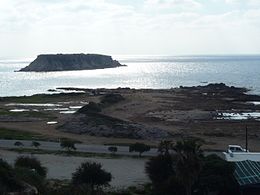
Native name: Γερόνησος | |
|---|---|
 Yeronisos Island, seen from the coast of Cyprus | |
 | |
| Geography | |
| Location | Cyprus |
| Coordinates | 34°54′N 32°19′E / 34.90°N 32.31°E / 34.90; 32.31 |
| Archipelago | Cyprus |
| Area | 26,000 m2 (280,000 sq ft) |
| Administration | |
| Demographics | |
| Population | 0 |
Yeronisos or Geronisos (Greek: Γερόνησος or Ιερόνησος; transl. Holy Island) is a small island lying off the west coast of Cyprus, some 18 kilometres north of Paphos. Uninhabited since the 15th century, recent excavations have revealed it once held a sanctuary dedicated to Apollo in the late Hellenistic period.
The island which lies 280 metres from the shore of western Cyprus has been uninhabited since the 14th or 15th century.[1] It has an area of 26,000 square metres and rises 21.65 metres from sea level.[2] Geologically the island consists of a hard calcarenite crust of Pleistocene marine terraces overlying a soft marl core.[2]
The toponym "Holy Island" is an ancient one. Pliny speaks of an island called "Hiera," near Paphos, and Strabo mentions a place called "Hierocepis" nearby Paphos and Akamas.[1] It is likely that the name refers to the Apollo sanctuary that stood there in the 1st century BC.[1]
The island was first excavated in 1982 by Sophocles Hadjisavvas following a proposal to build a hotel on the island.[2] He quickly established the presence of Hellenistic remains on the island, which halted all further attempts to build on the island.[2] In 1989, Joan Breton Connelly from New York University heard about the work and impressed by the range of the material joined the excavations which have continued since then.[1]
The excavations have established three periods of occupation on Yeronisos. Early Chalcolithic (3800 BC), late Hellenistic (80-30 BC), and Byzantine (6th-7th century and 13th century). The most intense of this activity is the late Hellenistic period at a time when Cleopatra ruled Cyprus.[2] Artefacts include coins, pottery, glass, and inscriptions.[3] Limestone amulets, identical to those used in Cypriot sanctuaries of Apollo, point to ritual activity and the worship of Apollo.[1] The island was apparently abandoned following a devastating earthquake in 1st century BC/AD.[3] Low-level activity on the island begins again in the 6th century AD. when a reservoir and animal shelters were built.[3]